
by Rick O'Connor | Aug 11, 2017
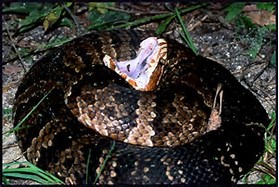
the “cottonmouth” gape of this venomous snakes is a warning. Notice the banded coloration of this individual.
Photo: UF IFAS Wildlife
Also known as the Water Moccasin, this is a snake that is all too familiar with most Floridians… Or is it? Several non-venomous water snakes are often confused with the cottonmouth and are thus killed. That said, cottonmouths are common in the state near areas of water and many residents do have encounters with them. This fact sheet will provide information that help reduce negative encounters with this venomous snake.
DESCRIPTION
- cottonmouths have a relatively thick-stout body with a broad head and thin neck
- they are generally banded and can be brown, gray, reddish in color; many become darker with age and may be solid black; cottonmouths who frequent tannic waters may have cooper color to them
- average length 36″ (3 ft.); max length 74″ (6 ft.)
JUVENILE DESCRIPTION
- copper colored with a yellowish-green tipped tail; used to attract prey
HOW TO TELL FROM NON-VENOMOUS WATER SNAKES
- there are several species of water snakes from the genus Neroidia which are confused with cottonmouths
- the scales between the eyes on top of the head are larger than others on the head; they have narrow necks
- Neroidia will have heads shaped more like your thumb and neck is as wide as head – NOTE: Neroidia CAN WIDEN THEIR HEAD WHEN THREATENED
- when head is viewed from above, the eyes of the cottonmouth are hard to see
- cottonmouths have a creamed colored cheek with dark “mask” extending from eye to back of lower jaw
- Neroidia may have creamed colored cheek but will lack “mask”; will possess thin vertical stripes that extend from lower to upper jaw
- there are single scales extending from the vent (anus) to tip of tail in cottonmouths; those same scales are divided into multiple ones on Neroidia
- the underside of the cottonmouth tail is usually dark; Neroidia is usually lighter in color
- pupil of cottonmouth is elliptical; it is round on Neroidia
- cottonmouths, being members of the pit viper family, will have heat sensing pit between nostril and eye; Neroidia will lack this pit
- scales are keeled, but this is true for some non-venomous snakes
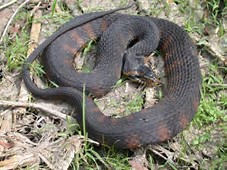
This banded water snake is often confused with the cottonmouth. This animal has the vertical stripes extending from the lower jaw, which is lacking in the cottonmouth.
Photo: University of Georgia
HOW TO TELL FROM OTHER PIT VIPERS
- cottonmouths are often confused with copperheads – both in same genus
- copperheads will lack characteristic “mask” found on cottonmouths and rattlesnakes
- the bands of the copperhead are more uniformed than the cottonmouth and are shaped like an hour glass
- copperheads are generally lighter in color
- it is difficult to tell young copperheads and cottonmouths apart; both have the light yellow-green tipped tail and light body coloring
SUBSPECIES OF COTTONMOUTHS
- there three recognized subspecies of cottonmouths
- the Florida Cottonmouth (Florida (A.p.conanti) – is darker, many times black, with two vertical bars on snout; found throughout the state of Florida
- the Eastern Cottonmouth (A. p. piscivorous) is lighter in color than the Florida and has no pattern on snout; found in extreme western Florida panhandle and the Appalachian valley of Alabama, Georgia, Tennessee, and North Carolina
- the Western Cottonmouth (A.p.leucostoma) – is similar to the eastern cottonmouth but darker in color; found in Mississippi, Louisiana, Texas, and Oklahoma
WHATS IN A NAME
- The Cottonmouth and the Water Moccasin are the two names for the same snake; herpetologist prefer to use the name Cottonmouth
- The snake was originally described by B.G.E. Lace (1789) using the term “piscivorous”; which means “fish eater”
- Gerard Troost (1836) describe the western subspecies using the term “leucostoma”; which means “white mouth”
- Howard Kay Gloyd (1969) described the Florida subspecies using the term “conanti”; which was honoring the herpetologist Roger Conant of the Philadelphia Zoo

Many in the panhandle use the terms cottonmouth and copperhead interchangeably. They are closely related but this photo of a copperhead shows the lighter coloration and the hour-glass shaped pattern of the blotches along the body.
Photo: UF IFAS Wildlife
BEHAVIOR
- cottonmouths are found throughout the southeast United States but avoid mountainous areas
- they are usually found with 30 feet of a water source, though some have been found as far as 100 feet away
- they prefer slow, quiet, backwater areas over faster flowing waterways
- they are most common in pine flatwoods but can be found in a variety of habitats and do well near humans
- they have been found in brackish water areas but freshwater is usually nearby
- they are becoming more common on barrier islands, and in some cases in high numbers, but do need sources of freshwater; they cannot extract from seawater
- cottonmouths hunt primarily at night; though daylight hunting happens
- on cool mornings they may climb lower branches of trees to bask; usually close to water
- they will remain still in one location for long periods of time waiting for prey to come within range; but they are known to stalk prey as well
- when prey are found they will strike using their hollow fangs to inject a hemotoxin; this venom is known to contain components that cause death, by attacking the muscle and circulatory system, and digestive enzymes to begin the process before swallowing
- in the cooler parts of their range cottonmouths will hibernate; but tend to be active year round in FL
PREY
- cottonmouths are carnivorous and opportunistic; prey include fish, small mammals, reptiles and birds; they will feed on smaller cottonmouths
- they are known to scavenge and are attracted to the smell of dead fish
- they hunt primarily at night but are known to during daylight hours as well
- they hunt fish and CAN bite underwater – despite the legend that they cannot
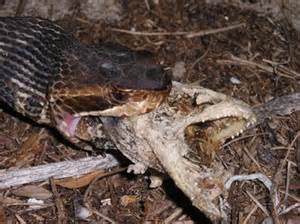
Cottonmouth’s are known to feed on a variety of prey including carrion.
Photo: University of Florida
PREDATORS
- primary predator include alligators, kingsnakes, and larger cottonmouths
- secondary predators include large mammals, birds, hawks, and owls
- cottonmouths tend to “freeze” when they first detect a predator – no movement at all
- if the predator gets too close they will vibrate their tail in leaf litter to alert the intruder and may gape their mouth showing the white inside of their “cottonmouth”; they may also flatten their bodies to appear bigger and release a musk as a warning
- they prefer to flee than bite but they will strike if they have nowhere to flee
REPRODUCTION
- mating occurs in spring and sometimes fall; in Florida they may mate year round
- males sense pheromones from females to know when it is time and, like other vipers, males may fight for the right to mate
- females can store sperm for long periods of time and typically breed every other year
- females give live birth in late summer to early fall; they sometimes congregate to give birth
- the average number of offspring/litter is 7-12 but can be as high as 22
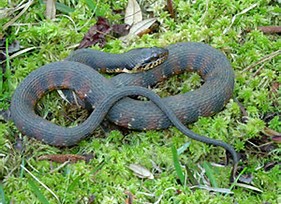
Is this a cottonmouth?
No, it is not…
Can you tell why?
Photo: University of Florida
DEALING WITH ENCOUNTERS
KEEPING THEM AT A DISTANCE
- when hiking in cottonmouth territory it is recommended to wear high boots and look down while walking; if you need to look ahead we recommend you stop walking – look ahead – and then put your eyes back to the ground while walking
- stay on trails; snakes do not like short grass; avoid walking in tall grass where they may be hiding
- to keep cottonmouths away from your home – reduce food sources, freshwater sources, and shelter areas
- cottonmouths like fish ponds and are often found in the filter system; they may be attracted to swimming pools
- cottonmouths also eat rodents; bird feeders, sacks of corn, wood and brush pikes can attract cottonmouth prey, and thus cottonmouths
- if you must have brush piles and bird feeders place them away areas where people frequent – away from front and back doors, sidewalks, etc.
- many properties have natural ponds and swimming pools; if encounters are a problem consider placing some small mesh fencing to keep them from reaching the source may be helpful; this fencing should be buried 2-6″ below the surface and the wooden stakes should be on your side of the fence – snakes can climb the rough wood stakes; if you cannot continue the fencing across your entire property – make a 90° turn AWAY from your property to encourage them to return from where they came
IF I ENCOUNTER ONE
- despite stories, cottonmouths do not chase people; most will sit very still hoping you do not see them; I have personally accidentally placed my foot within inches of a cottonmouths with no reaction from the snakes; their first reaction is to “freeze”
- if they feel you are getting too close they often will begin to vibrate their tail very fast; this means they are getting nervous and are warning you to stay clear; many times they are in leaf litter when they do this and you can hear them – DO NOT APPROACH ANY CLOSER; the probability of a strike is still low, but has increased
- another warning behavior is mouth gaping and showing of white mouth- “cottonmouth”; though strike probability is still low, studies show that gaping cottonmouths tend to strike more often than tail vibrating ones – DO NOT APPROACH; move back and allow the snake to pass

The dark phase of the cottonmouth. This is an older individual.
Photo: UF IFAS
BUT WHAT IF I ALLOW IT TO PASS AND IT IS HEADING FURTHER ON TO MY PROPERTY?
- great news right?
- statistics show that about 95% of people bitten by snakes are trying to catch it or kill it – so trying to remove it yourself significantly increases your chance of getting bit
- many have had success with sweeping non-venomous snakes into a trash can with a broom and releasing somewhere… But these are non-venomous snakes, we recommend professionals for venomous snake removal
- you may have no other optional than to kill the snake; if this is the case be careful… Again, many are bitten trying to kill snakes; also know that snakes are known to strike after they are a dead
WHAT IF I AM BITTEN?
- first know that death from cottonmouths is very rare; annually in the U.S. about 7,000 – 8,000 people are bitten by venomous snakes (about 1 in 40,000 people) and about 5-6 die (about 1 in 50 million)
- also know that many times vipers give what is called a “dry bite” – no venom injected; but you do not know this so treat as if venom was injected; MANY WHO DIE FROM VENOMOUS SNAKE BITES DID NOT SEEK MEDICAL ATTENTION
- first rule is DO NOT GET BIT TWICE; after being bit many people will then try to kill the snake and are bitten again; many feel that they need the snake at the hospital for identification – they do not
- second rule is to remain calm; easier said than done, but an elevated heart rate will move the toxin within the blood faster
- with toxic viper bites there will be pain and swelling; remove watches, jewelry, or any tight fitting clothing from bite area
- you do not need to add ice or heat
- we do not recommend tourniquets, lancing the bite and sucking out venom; many times the venom has spread from the bite area and health officials have found that many times there are more problems with the “first aid” than with the bite itself
- try not to move the limb where bite occurred- easier said than done; if you can elevate your heart above the bite this is good
- do not drink alcohol; you may think you need a drink right now but you do not; alcohol or caffeine can accelerate heart and spread venom faster
- call 911 and alert the closest hospital that you have a snake bite victim coming in; answer any questions they may have to the best of your ability
- again, do your best to relax and get to a hospital; fatalities are rare due to the excellent medical care in this country
All of this said, there is a lot of concern surrounding cottonmouths in Florida. As we expand our neighborhoods into more of their habitat, we will encounter more of them. In some cases, the location for their resources may be our neighborhoods. We will need to learn how to identify them and understand their behavior to avoid negative encounters. The statistics show that they are not as big a threat as they are perceived to be, but folks are still concerned for their family and pets – and understandably so. Hopefully information in this fact sheet will be of help to you.
REFERENCES
Ashton, R.E., P.S. Ashton. 1981. Handbook of Reptiles and Amphibians of Florida; Part I Snakes. Windward Publishing. Miami FL. pp. 175.
Gibbons, W., M. Dorcas. 2005. Snakes of the Southeast. University of Georgia Press. Athens, GA. Pp. 253.
Gibbons, W. 2017. Snakes of the Eastern U.S. University of Georgia. Athens GA. pp. 416.
http://www.bioone.org/doi/abs/10.2994/1808-9798(2008)3%5B175:TEOICS%5D2.0.CO%3B2
http://www.bioone.org/doi/abs/10.1643/CH-04-243R1?journalCode=cope
https://academic.oup.com/bioscience/article/58/10/947/245888/Pitviper-Scavenging-at-the-Intertidal-Zone-An
http://escholarship.org/uc/item/9j69w675
http://ufdc.ufl.edu/files/UFE0046057/00001/WIXSON_J.pdf
http://www.herpconbio.org/Volume_10/Issue_2/Hanson_McElroy_2015.pdf
http://onlinelibrary.wiley.com/doi/10.1111/j.1365-2699.2008.02075.x/full
http://www.bioone.org/doi/abs/10.1643/0045-8511(2002)002%5B0195:DBOCAP%5D2.0.CO%3B2
https://academic.oup.com/beheco/article/15/2/365/223992/Size-based-variation-in-antipredator-behavior
http://www.jstor.org/stable/3890390?seq=1#page_scan_tab_contents
https://www.floridamuseum.ufl.edu/herpetology/fl-snakes/list/agkistrodon-piscivorus-piscivorus/
http://ufwildlife.ifas.ufl.edu/pdfs/cottonmouth.pdf
Johnson, S.A. Frequently Asked Questions About Venomous Snakes. http://ufwildlife.ifas.ufl.edu/venomous_snake_faqs.shtml.
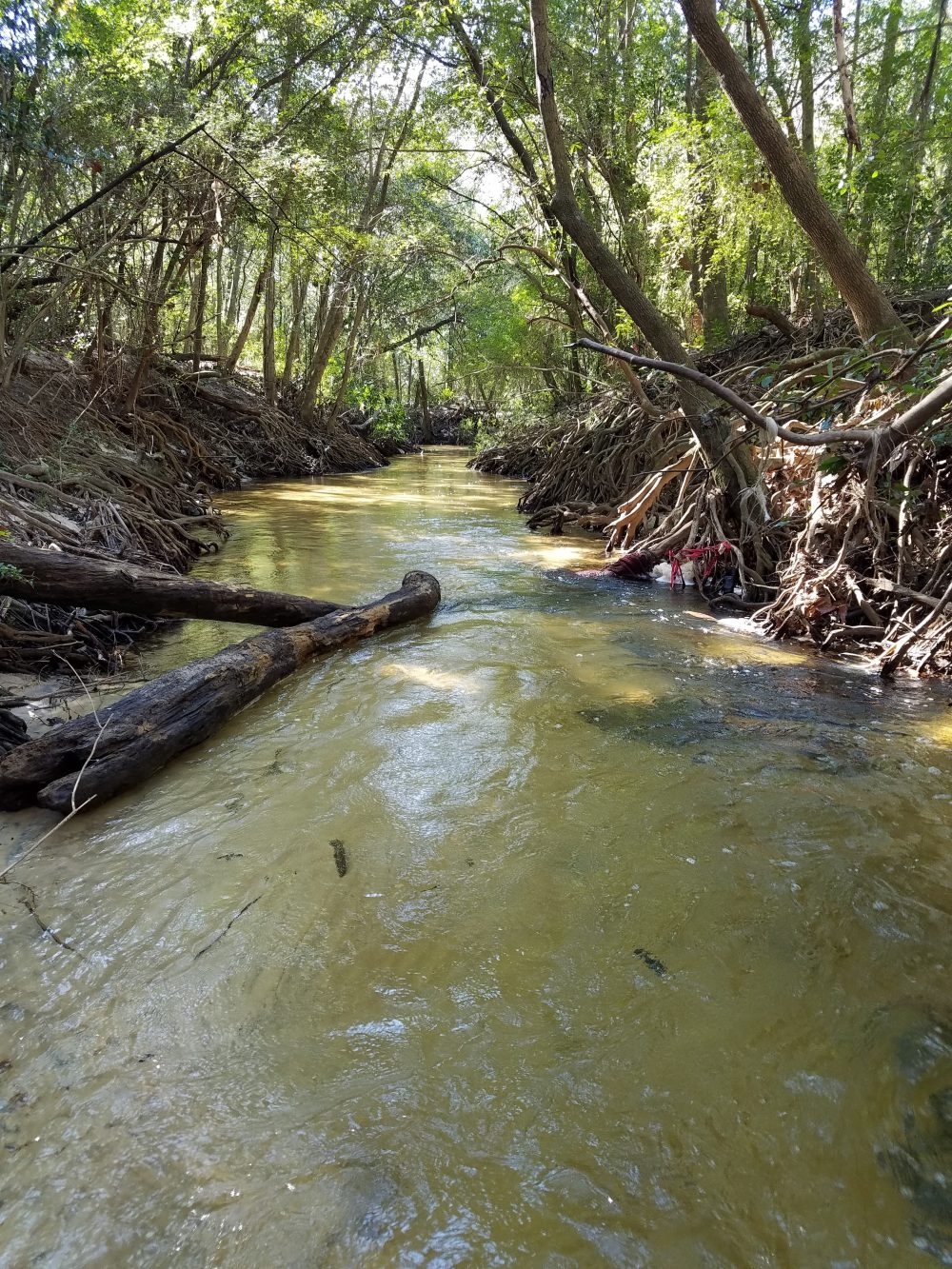
by Rick O'Connor | Jul 29, 2017
ARTICLE BY DR. MATT DEITCH; water quality specialist – University of Florida Milton
Summer is a great time for weather-watching in the Florida panhandle. Powerful thunderstorms appear out of nowhere, and can pour inches of rain in an area in a single afternoon. Our bridges, bluffs, and coastline allow us to watch them develop from a distance. Yet as they come closer, it is important to recognize the potential danger they pose—lightning from these storms can strike anywhere nearby, and can cause fatality for a person who is struck. Nine people were killed by lightning strike in Florida in 2016 alone, more than in any other state. Because of the risk posed by lightning, my family and I enjoy these storms up-close from indoors.
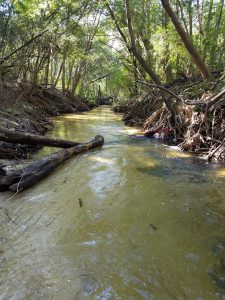
Carpenter’s Creek in Pensacola
Photo: Dr. Matt Deitch
A fraction of the rain that falls during these storms is delivered to our bays, bayous, and estuaries through a drainage network of creeks and rivers. This streamflow serves several important ecological functions, including preventing vegetation encroachment and maintaining habitat features for fish and amphibians through scouring the streambed. High flows also deposit fine sediment on the floodplain, helping to replenish nutrients to floodplain soil. On average, only about one-third of the water that falls as rain (on average, more than 60 inches per year!) turns into streamflow. The rest may either infiltrate soil and percolate into groundwater; or be consumed and transpired by plants; or evaporate off vegetation, from the soil, or the ground surface before reaching the soil. Evaporation and transpiration play an especially large role in the water cycle during summer: on average, most of the rain that falls in the Panhandle occurs during summer, but most stream discharge occurs during winter.
The water that flows in streams carries with it many substances that accumulate in the landscape. These substances—which include pollutants we commonly think of, such as excessive nutrients comprised of nitrogen and phosphorus, as well as silt, oil, grease, bacteria, and trash—are especially abundant when streamflow is high, typically during and following storm events. Oil, grease, bacteria, and trash are especially common in urban areas. The United States EPA and Florida Department of Environmental Protection have listed parts of the Choctawhatchee, St. Andrew, Perdido, and Pensacola Bays as impaired for nutrients and coliform bacteria. Pollution issues are not exclusive to the Panhandle: some states (such as Maryland and California) have even developed regulatory guidelines in streams (TMDLs) for trash!
Many local and grassroots organizations are taking the lead on efforts to reduce pollution. Some municipalities have recently publicized efforts to enforce laws on picking up pet waste, which is considered a potential source of coliform bacteria in some places. Some conservation groups in the panhandle organize stream debris pick-up days from local streams, and others organize volunteer citizens to monitor water quality in streams and the bays where they discharge. Together, these efforts can help to keep track of pollution levels, demonstrate whether restoration efforts have improved water quality, and maintain healthy beaches and waterways we rely on and value in the Florida Panhandle.
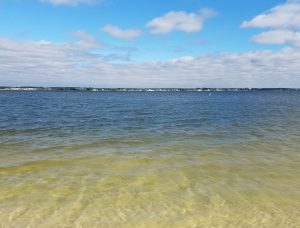
Santa Rosa Sound
Photo: Dr. Matt Deitch
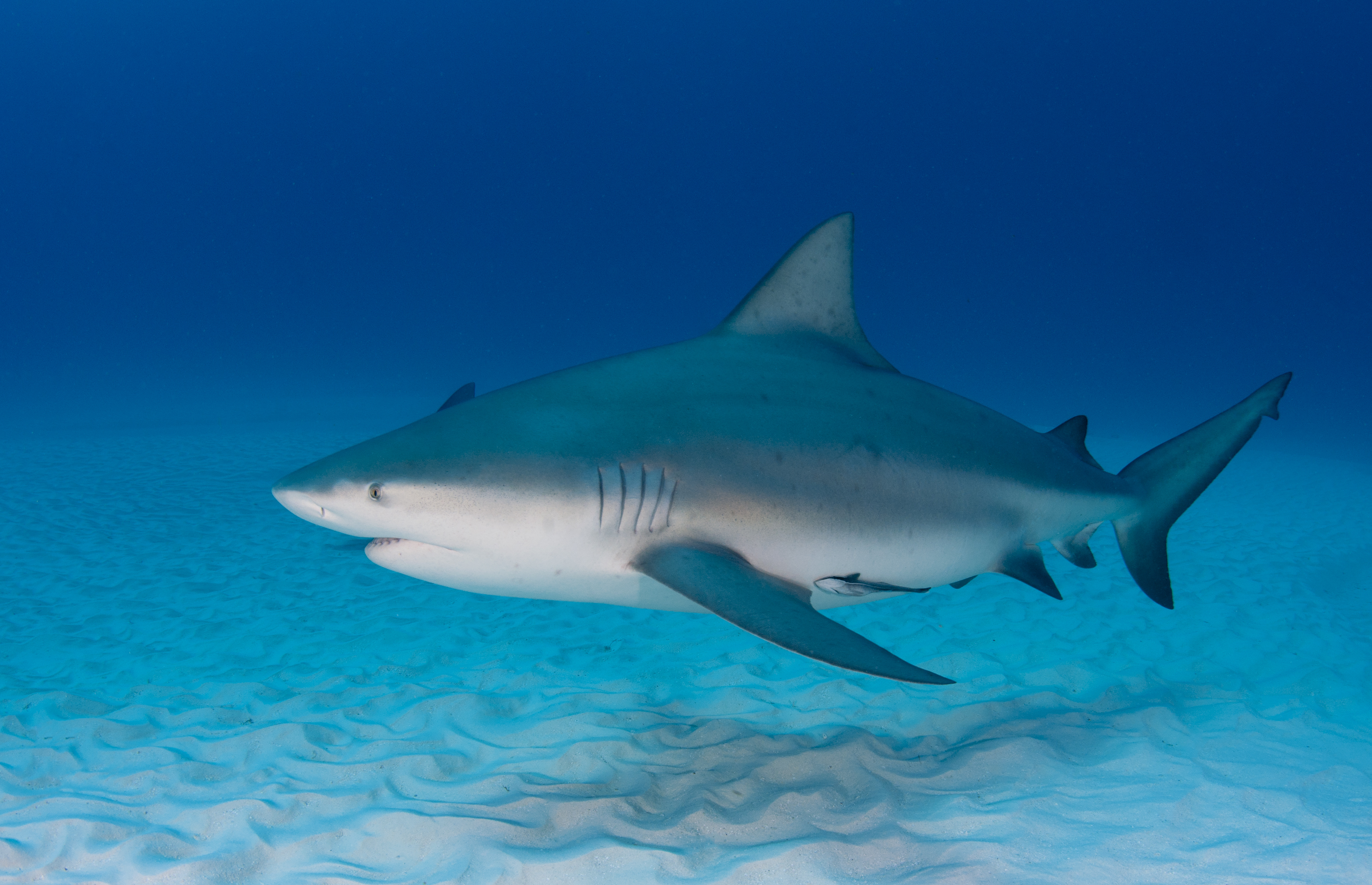
by Rick O'Connor | Jul 12, 2017
I am calling this “Summer of Sharks” as if this summer is more of a problem than others are. In fact, it is not… no more, so than any other summer –so we could call any summer the “summer of sharks”.
“Shark Fever” is more correlated with when and how the press covers the topic. During summer, more people see sharks near shore – and this is unnerving. So are there more sharks? Are there more attacks? Do the unusually warm winter and Gulf waters cause the increase?

Pregnant Bull Shark (Carcharhinus leucas) cruses sandy seafloor. Credit Florida Sea Grant Stock Photo
Let us start with the first question – are there more sharks in the Gulf than there used to be?
Though most of the papers I reviewed were published over 10 years ago – they suggest several species of sharks have actually been on the decline due to incidental catch in long line operations. This reduction due to by-catch suggest a need for population management. According to the NOAA Fisheries site, the quota for commercial sharks in the Eastern Gulf of Mexico for 2016 was 127.8 metric tons (amount varied by species). The actually percent of the quota landed was around 70%. In the Western Gulf during 2016, 350.4 metric tons were allowed and between 49 – 141% of the quota (depending on species) was logged by March of 2016; at which time those federal waters were closed to shark fishing. So far, in 2017 the Western Gulf is again closed due to quota already taken while the Eastern Gulf has reached between 30-40% of the quota.
These data suggest that the fishermen in the Western Gulf are either dealing with a lot of sharks and making the quota quickly or there is heavy fishing pressure on this population.
So why more coastal encounters?
Discussing the recent increase in contact between anglers and mako sharks near Pensacola, Dr. Wayne Bennett (University of West Florida) believes this is due to more divers/fishermen in the environment and thus more encounters; and not more makos interested in inshore waters. In other words, they have always been here – there are just more of us in the environment, and thus more of us seeing them. With Go-pros and cell phones, these encounters are moving through social media and more of us are aware of these encounters. Dr. George Burgess (University of Florida) has a similar comment about recent white shark encounters along the Gulf coast.
Are there more attacks?
To answer this – we review the International Shark Attack File housed at the Florida Museum of Natural History at the University of Florida.
According to the ISAF data – 2016 was “average”. 84 unprovoked shark attacks occurred worldwide in 2016; compared to the annual mean of 82. 2015 however was a busy year with 94 unprovoked attacks logged. ISAF goes on to state there is a correlation between the time humans spend in the sea and the number of attacks that occur. They go on to state that if shark populations remain the same or increase; you might expect an increase in attacks. However, if the populations were low or declining, you would expect a decrease in attacks.
ISAF has unprovoked shark attack data going back to 1580. During that time, the United States and Australia account for 67% of all attacks – but these are two nations where the citizens really love water sports. The U.S. alone accounts for 46% of all attacks. Within the U.S., Florida accounts for 58% of all shark attacks, followed by Hawaii, California, and the Carolina’s – all states where water sports are very popular.
Just because we are interested – in Florida, 54% of the attacks have occurred in Volusia (Daytona) and Brevard counties – both very popular with the surfing public. Along the Florida Panhandle, we have Bay County (Panama City Beach) with 9 attacks, Escambia (Pensacola Beach) with 6, Okaloosa (Destin) with 3, Gulf (Port St. Joe) and Franklin (St. George Island) both with 2, and finally Walton (Seaside), and Santa Rosa (Navarre) both with 1 attack each. This is a total of 24 attacks that equates to 3% of the total number of attacks in the state of Florida since 1580.
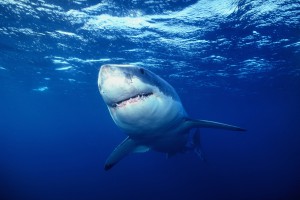
White Shark (Carcharhinus carcharias). Credit: Florida Sea Grant Stock Photo
So what does all of this mean?
- There is concern about the decline of some shark populations due to either commercial catch or commercial by-catch. NOAA is trying to manage this.
- More people are encountering sharks, but this in not believed to be due to more sharks in the water – actually, because there are more people in the water.
- Shark attacks are rare, and in the panhandle – very rare.
Therefore, the sharks are here and it is fair to say that if tourism in the Panhandle continues to increase the number of human-shark encounters will as well. It will continue to be “the summer of sharks”.
Resources:
Sharks in the Gulf of Mexico: Facts
http://www.pewtrusts.org/en/research-and-analysis/fact-sheets/2012/03/12/sharks-in-the-gulf-of-mexico-the-facts
Shifting baselines and the decline of pelagic sharks in the Gulf of Mexico
http://onlinelibrary.wiley.com/doi/10.1111/j.1461-0248.2003.00564.x/full
Atlantic Shark Commercial Fishery Landings and Retention Limit Update from January 1 – December 31, 2016
http://www.nmfs.noaa.gov/sfa/hms/news/news_list/2017/1/shk_landings_update_011717.html.
ISAF 2016 Worldwide Shark Attack Summary
https://www.floridamuseum.ufl.edu/fish/isaf/worldwide-summary/
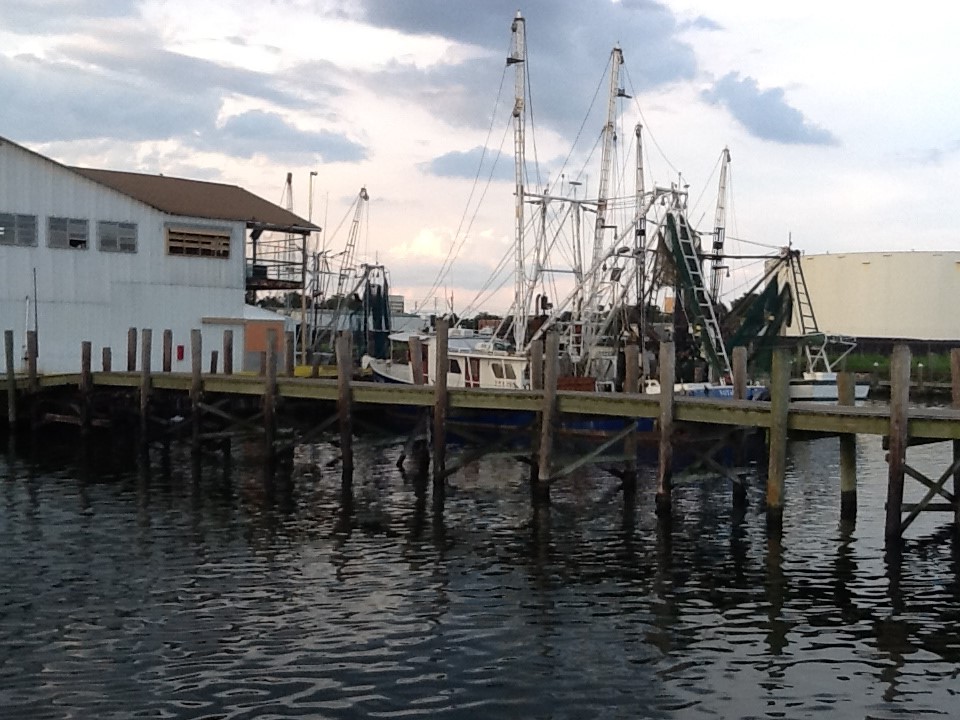
by Rick O'Connor | Jun 17, 2017
ARTICLE WRITTEN BY DR. CHARLES ADAMS, FLORIDA SEA GRANT
The demand for seafood in the US continues to grow. This growth is a function of a number of factors, including the increased awareness of the healthful attributes of many finfish and shellfish products, the increased availability of several key imported, cultured species (shrimp, tilapia, pangasius), and more convenient packaging for home consumption, to name just a few. In terms of wild-caught seafood, effective management at the state and federal level helps ensure the sustainable harvest of traditionally important species, such as reef fish, scallops, flounders, mackerels, and crab.

The famous blue crab.
Photo: FWC
According to the latest data from the National Marine Fisheries Service (NMFS), the US domestic fisheries fleet landed about 7.8 billion pounds of edible seafood products, valued at $5.2 billion. Florida plays an important role in this industry, particularly within the Gulf and South Atlantic region. Approximately $250 million worth of seafood is landed by the commercial harvesters in Florida on an annual basis, with some species being landed in Florida, and virtually nowhere else … including pink shrimp, spiny lobster, grouper and stone crab. But wild harvest is not the only source of finfish and shellfish products.
The commercial aquaculture industry is also growing, as the demand for species grown within controlled systems (such as catfish, oysters, striped bass, crawfish, and salmon) continues to increase. The latest NMFS data indicates that the commercial aquaculture industry in the US harvests approximately $1 billion worth of freshwater and saltwater species annually. The success story for aquacultured food items in Florida is molluscan shellfish, in particular cultured hard clams.
Though our wild seafood stocks are sustainably managed and aquaculture production is increasing, approximately 90% of the seafood consumed in the US is imported. Our domestic harvest and culture of seafood simply cannot keep up with demand. We are eating more and more seafood … with the latest NMFS estimate of annual, per capita seafood consumption being 15.5 lbs (edible meat weight). This is the highest level of per capita consumption since 2010. Even though demand is growing, consumers should be confident that the traditional species from our nation’s wild stocks will be there in the future. In addition, the aquaculture industry will help the seafood industry keep pace with growing demand. The seafood industry will continue to be an important source of incomes, jobs, and tax revenue for our coastal communities. And given the increasing number of cultured species and innovative packaging/preparation methods … now is a great time to be a seafood consumer!!
For more information about the US seafood industry, go to https://www.st.nmfs.noaa.gov/Assets/commercial/fus/fus15/documents/FUS2015%20Fact%20Sheet.pdf.

by Rick O'Connor | May 27, 2017
On May 7, 2017 Marsha Stanton spotted a manatee swimming by her pier in Big Lagoon near Pensacola. I am sure this was an exciting moment and Marsha was interested in letting someone know so that the unusual encounter could be logged.
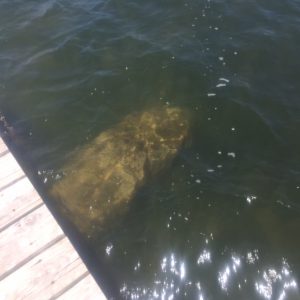
Manatee swimming by a pier near Pensacola.
Photo: Marsha Stanton
There are four species of manatee in the world; the West Indian Manatee (Trichechus manatus) is the one native to the South Atlantic, Caribbean, and Gulf region. The Florida Manatee (T. manatus latirostris) is a subspecies that is found in Florida. The historic range of the Florida Manatee included all of the Gulf coast and the east coast as far as the Chesapeake Bay. However, the increase in humans triggered a decrease in manatees. In the 1970’s it was rare to find the animal outside of the Florida peninsula.
Florida first began protecting the animal in 1893 and today it is protected by the state with the Manatee Sanctuary Act, the federal Marine Mammal Protection Act, and the federal Endangered Species Act. In the 1970’s the population of Florida Manatees was estimated to be about 1000 animals, today there are an estimated 6000. Due to the increase throughout its range, the animal has now been moved from ENDANGERED to THREATENED. In 2016, 521 manatee deaths were logged with FWC. The average for a month was 43. The majority of these were logged as unknown or perinatal (associated with the weeks before and after birth) and the highest for a month was in February. Boat strikes were logged as the largest problem for the months of January and July.
All that said, we would certainly like to protect any manatee that visit’s our area. So what can we do?
- If boating, use the marked channels. There is evidence that manatees try to avoid boat traffic by staying out of the boating areas.
- If you must leave the channel to reach your dock or the beach do so at idol speed. Wear polarized glasses and have a look out. Manatees do not break the surface as dolphins do, rather they generate “swirling eddies” as they move beneath the surface. So slow your movement and have a watchful eye and we can help reduce problems.
- If snorkeling, diving, or swimming near a manatee do not approach the animal; this can be stressful for them and could be reported as harassment by FWC; which could come with a fine. Allow the animal to move as it wishes and enjoy the experience.
- The same goes for a kayak or paddle encounter. Do not chase the manatee or separate mother from calf.
- Another issue has been feeding manatees or providing them freshwater from a hose. This practice has gone on a long time but researchers now know that this decreases the fear of humans by manatees and they return. This can cause boat strikes to increase. It is also considered harassment.
Marsha was interested in letting researchers know about this unusual encounter. However, researchers, and FWC, do not necessarily consider this as unusual as we think. Manatees have become a main stay at Wakulla Springs State Park during the colder months and are common enough in the Mobile Bay area that a manatee watch program has been developed. If the animal is distressed, injured, or you find a dead one you can report this to FWC at (888) 404-3922. If the animal is fine, healthy, and swimming just follow the basic rules listed above and enjoy a really cool experience with this really cool Floridian.
More information on “do’s” and “don’ts” can be found at
http://myfwc.com/education/wildlife/manatee/viewing-guidelines/.
http://myfwc.com/media/415226/manatee_fltreasure_bklt.pdf
















